17.01.2019
Hayabusa2 team sets date for sample collection, considers two touchdown sites

Japan's Hayabusa2 spacecraft will try to collect a sample from asteroid Ryugu during the week of 18 February, mission officials said during a press briefing last week. Should problems arise, a backup week is available starting 4 March. The team is now considering two sample collection sites, the smaller of which is just a few meters across.
Hayabusa2 spent the end of 2018 looping a safe distance from asteroid Ryugu and back again during solar conjunction, returning to its home position 20 kilometers away on 29 December.
JAXA's website has some interesting details about how the team tried to communicate with—or at least, get some very basic information from—Hayabusa2 during solar conjunction. Computer data is binary, a stream of zeros and ones. Spacecraft transmit the zeros and ones by varying the intensity of the spacecraft's radio signal. Unfortunately, when a spacecraft is next to the Sun in the sky, plasma near the Sun's surface interferes with the signal, making the intensity fluctuate so badly some zeros look like ones and some ones look like zeros. To compensate for this, Hayabusa2 sent the same information multiple times. Engineers gave computer algorithms on Earth several copies of the same message, using them to sort out which parts of the signal were supposed to be zeros and which parts were supposed to be ones.
Now that Ryugu and the Sun aren't so close to each other in the sky, Hayabusa2 is back to normal operations, and that means preparing for touchdown and sample collection! The first touchdown is planned for the week of 18 February, with a backup the week of 4 March.
As a reminder, Ryugu is surprisingly rocky, and there are very few places to safely bring the spacecraft down to collect a sample. The team is still considering a circular, 20-meter-wide site called L08-B—more specifically, an irregular region within that called L08-B1—but they are also eyeballing another spot a few meters away called L08-E1.
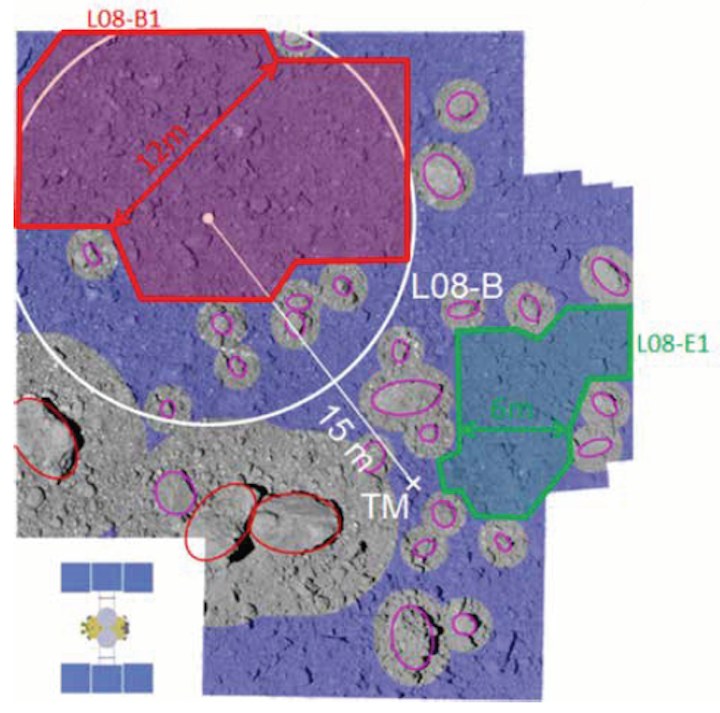
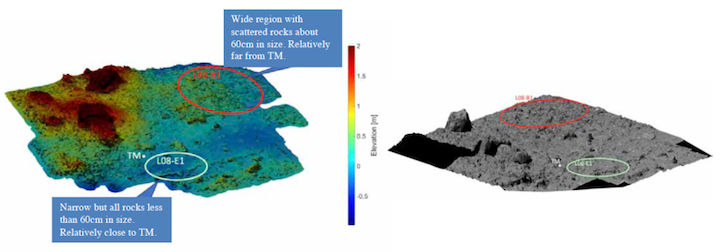
There are pros and cons to both sites. L08-B1 is 12 meters wide at its narrowest point, which gives Hayabusa2 plenty of margin (the spacecraft measures 6 meters wide across its solar panels). But despite being free of larger boulders, L08-B1 is scattered with rocks about 60 centimeters in size. The spacecraft's sampler horn is only a meter long.
L08-E1, on the other hand, has smaller rocks, under 60 centimeters in size. But here's the catch: at its narrowest point, the landing site is just 6 meters wide—the same size as the spacecraft. At first, I assumed this meant the spacecraft would have to turn 90 degrees to safely grab a sample from L08-E1, like a car pulling in to a parking space. However, in clarifying this with the team, I learned that isn't necessarily the case. The landing areas are simply where the sampler horn can touch; the entire spacecraft doesn't actually have to fit into those. The sampler horn sticks a meter down from the spacecraft, and then there's another 1.25 meter or so of spacecraft between the base of the horn and the solar panels.
The team also says that they can be confident of the spacecraft's position roughly within about 1 meter. Stop and think about that for a moment: Ryugu is 354 million kilometers from Earth. It takes radio signals, traveling at the speed of light, 20 minutes to travel that far. And Hayabusa2 can touch down on Ryugu with an accuracy of a single meter.
Another advantage of L08-E1 is that it's closer to the target marker the spacecraft dropped, just a few meters away, meaning Hayabusa2 can keep it in sight for longer as it descends to collect a sample. The team has decided not to drop another target marker, according to Makoto Yoshikawa, the Hayabusa2 project mission manager.
"Two target markers in the same area can cause trouble for the autonomous operation," he said in an email. "This is a risk. So we have decided not to use extra target makers."
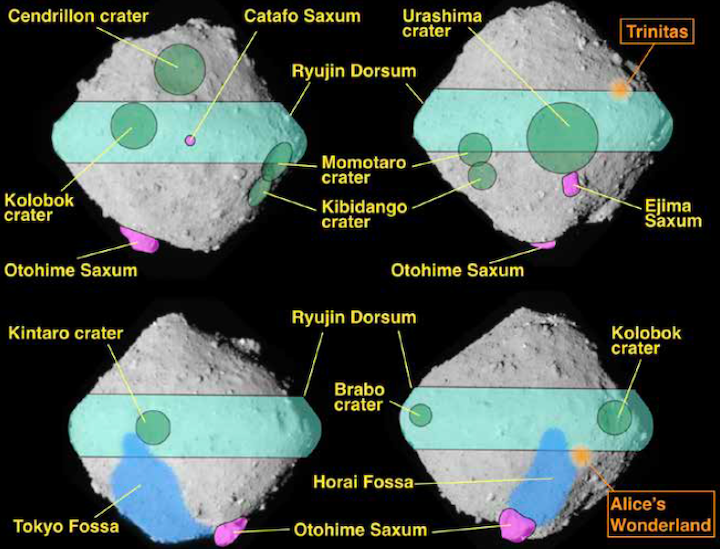
JAXA
RYUGU NAMED FEATURES
The names in yellow are all officially recognized by the International Astronomical Union, while the two in orange are unofficial. Trinitas and Alice’s Wonderland are nicknames of the MINERVA-II1 and MASCOT landing sites, respectively.In other mission news, the team has released a map of named Ryugu surface features, with the theme of "children's stories." The names in yellow are all officially recognized by the International Astronomical Union; while the two in orange are unofficial.
Last week's press materials say the Hayabusa2 team submitted their proposal to use the children's-story theme for names to the IAU on 28 June 2018, the day after they arrived at Ryugu. A working group accepted the theme three months later, on 25 September. On 12 October, the team proposed 13 surface feature names along that theme. Nine of those names were accepted as proposed, and 4 were accepted after some further discussion with the IAU.
Perhaps the most notable outcome from these new names is that we can now officially call the giant boulder at Ryugu's south pole Otohime Saxum. "Saxum" is Latin for boulder, and Otohime is the name of an undersea princess connected to the story of Ryugu. That story, as I understand it, says that Ryugu was an underwater dragon palace. A fisherman named Urashima (a newly named Ryugu crater) traveled there on a turtle, where he received a treasure box (read: surface sample) from Otohime!
Here's a good image with Otohime Saxum in it. Note that here, it's at the top of Ryugu—most of the images released by JAXA before September had the south pole on top.
Quelle: The Planetary Society
----
Update: 6.02.2019
.
Hayabusa 2 probe to try to land on asteroid Ryugu on Feb. 22: JAXA
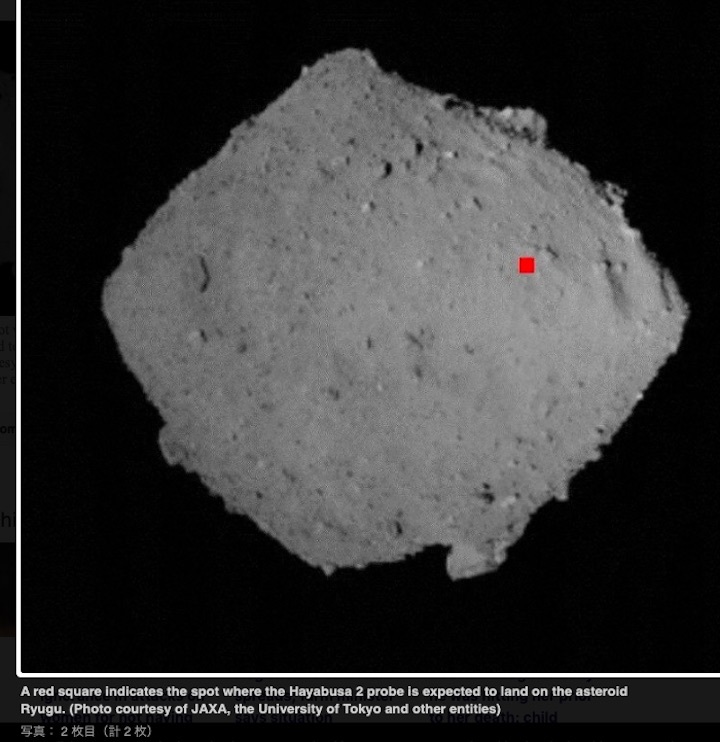
TOKYO -- The Japan Aerospace Exploration Agency (JAXA) will try to land its Hayabusa 2 probe on the asteroid Ryugu on Feb. 22, the agency said on Feb. 6.
In its landing mission, Hayabusa 2 will use target markers it released earlier on the celestial object, and attempt to collect rocks and sand from the surface and bring them back to Earth.
JAXA postponed Hayabusa 2's scheduled landing in October last year due to the unexpectedly rocky surface conditions of the asteroid.
The Hayabusa 2 probe was launched on an H-IIA rocket from the Tanegashima Space Center in Kagoshima Prefecture, southern Japan, on Dec. 3, 2014, and is expected to leave the asteroid sometime around the end of 2019 and return to Earth in late 2020.
Quelle: The Mainichi
+++
Japan's Hayabusa2 probe to land on asteroid on Feb 22
A Japanese probe sent to examine an asteroid in order to shed light on the origins of the solar system is expected to land on the rock later this month, officials said Wednesday.
The Japan Aerospace Exploration Agency (JAXA) said the Hayabusa2 probe is expected to touch down on the Ryugu asteroid at 8am local time on February 22.
"The landing point is decided and how we're going to land is confirmed, so we want to do our best to achieve this without making mistakes," JAXA project manager Yuichi Tsuda told reporters.
The announcement comes after the agency in October delayed the touchdown for several months, saying they needed more time to prepare the landing as the latest data showed the asteroid's surface was more rugged than expected.
Scientists are already receiving data from other probes deployed on the surface of the asteroid.
In October, JAXA successfully landed a new 10-kilogramme (22-pound) observation robot known as MASCOT -- "Mobile Asteroid Surface Scout."
Loaded with sensors, the robot can take images at multiple wavelengths, investigate minerals with a microscope, gauge surface temperatures and measure magnetic fields.
Hayabusa2, about the size of a large fridge and equipped with solar panels, is the successor to JAXA's first asteroid explorer, Hayabusa, which is Japanese for falcon.
The Hayabusa2 mission, which costs around 30 billion yen ($260 million), was launched in December 2014 and will return to Earth with its samples in 2020.
Photos of Ryugu -- which means "Dragon Palace" in Japanese, a castle at the bottom of the ocean in an ancient Japanese tale -- show an asteroid shaped a bit like a spinning top with a rough surface.
By collecting samples from it, scientists hope to answer some fundamental questions about life and the universe, including whether elements from space helped give rise to life on Earth.
Quelle: France24
+++
★ Hayabusa2 status (week of 2019.1.7) ★
With solar conjunction and the New Year holiday now over, Hayabusa2 operations have ramped up this week. First was the tour operation. We moved to a region (so-called BOX-B) that is shifted slightly from the usual home position (so-called BOX-A) and conducted a series of scientific observations. By moving along the X-direction, we were able to acquire data with the Sun directly behind the spacecraft. Next was the vibration test for the sampler. The purpose was to confirm that Hayabusa2 will not perform an emergency escape if it incorrectly detects the vibration of the sampler before landing. Hayabusa2 was moved in the sequence of the final descent phase and acquired data on how the sampler vibrates. The final task was to do with the pressure that regulates the chemical propulsion system. In order to perform a ΔV test in the next week in preparation for the future SCI operation, we pre-adjusted the pressure of the fuel and oxidiser tanks to ensure standard values. “Let’s safely land!” Hayabusa2 is working hard to realise the hope of the New Year after a refreshing rest!
2019.1.16 O.M.
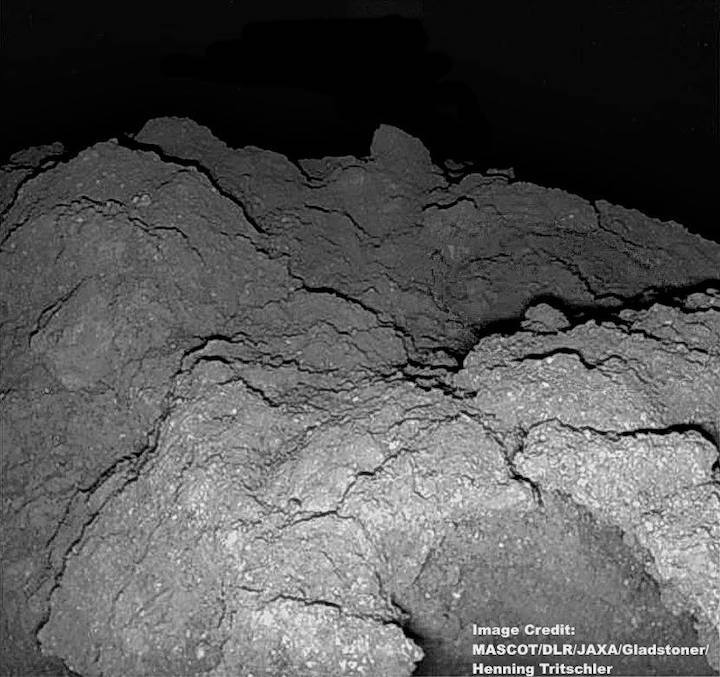
★ Hayabusa2 status (week of 2019.1.14) ★
On 1/16, we conducted a prolonged injection test for the RCS (chemical thrusters) in preparation for the SCI (impactor) operation. After separating the impactor in the SCI operation, the spacecraft will swiftly hide behind the asteroid to avoid flying debris generated by the explosion. This involves a RCS thruster injection for about 20 seconds in the ±X and ±Z direction, during which time a translational force of several 10s N will be applied to the spacecraft. This test checked whether attitude control and the RCS subsystem functions worked as expected under a strong disturbance that is not usually experienced. Although the test was run for about half the final injection time, both the attitude control and RCS subsystem worked almost as expected and we acquired valuable data for the actual SCI operation. In addition, on 1/18 following the operation of the previous week, we tested the vibration of the sampler horn and gathered the remaining necessary data.
2019.1.21 Y.M.
★ Hayabusa2 status (week of 2019.1.21) ★
This week was the tour or “BOX-B” operation. Here, the spacecraft’s altitude is lowered from the Home Position (HP) by about 2km and shifted towards the north pole by about 9km. We moved slowly over several days, arriving on 1/24. In the previous BOX-B operation, we observed the south pole hemisphere of the asteroid, so this time we moved to observe the north pole region from above. We stayed at that location for about 1 day to make scientific observations, after which a ΔV (acceleration) was performed and we are now returning to the HP (schedule to arrive at HP on 1/31). Observations were made with all scientific instruments; ONC, TIR, NIRS3 and LIDAR. Working with both the Goldstone and Madrid ground stations, as well as Usuda, we were able to acquire the observational data over the weekend. We also gathered additional valuable data, including a health check for the ONC and dark imaging from the TIR during the tour.
2019.01.29 M.H.
+++
Locations on the surface of Ryugu
have been named!
Place names for locations on the surface of Ryugu were discussed by Division F (Planetary Systems and Bioastronomy) of the International Astronomical Union (IAU) Working Group for Planetary System Nomenclature (hereafter IAU WG) and approved in December 2018. We will introduce the place names in this article and the background to their selection.
As the appearance of Ryugu gradually became clear during the approach phase in June 2018, we used nicknames amongst the Hayabsua2 Project team to distinguish regions of the terrain. (For example, the crater now named “Urashima” was referred to as the Death Star crater in Star Wars!) However, in order to introduce Ryugu to the world, it is necessary to have names that are intentionally recognized rather than nicknames, which can be referred to in scientific papers and other articles. Therefore, the discussion regarding naming the Ryugu surface topology began within the team.
To name a place on a celestial body in the Solar System, you must first decide on a theme. For example, the theme for places on Venus is the “names of goddesses”. During discussions between the domestic and overseas project members, suggestions such as “names of castles around the world”, “word for ‘dragon’ in different languages” and the “names of deep-sea creatures” were proposed for the place name theme on Ryugu. After an intense debate, the theme was selected to be “names that appear in stories for children” and a theme proposal was put to the IAU WG. The proposal was accepted on September 25, after which the discussion moved to selecting the topographical features to be named and the choice of name.
Names cannot be attributed to any location. Instead, there are restrictions on the places that can be assigned an official name involving considerations such as scientific importance or size on the celestial body. With this in mind, volunteers from the project members as well as planetary geology experts (hereinafter referred to as the Place Name Core Members ※1) discussed the place selection and completed the application forms for naming based on the exploration data. On October 12, we proposed 13 place names to the IAU WG. After additional discussion with the WG, 9 were accepted as proposed by the team and the remaining 4 names were approved after an amendment suggested by the IAU.
The surface of celestial bodies has a range of different topologies. We applied to give names to four different topology types on the Ryugu surface. The first type is “dorsum” which originates from the Latin for peak or ridge. The second type is “crater” which are familiar structures on the Moon and asteroids. Then “fossa” meaning grooves or trenches and finally the Latin word “saxum” for the rocks and boulders that are a main characteristic of the Ryugu terrain. Saxum is actually a new classification of terrain type that we applied to introduce due to the nature of Ryugu.
Numerous boulders are distributed on the surface of Ryugu. Regardless of where you look, there are rocks, rocks and more rocks. This is a major characteristic of Ryugu and continues to make plans for the touchdown operation of the spacecraft difficult. Additionally, spectroscopic observations revealed that the giant boulder (Otohime saxum) at the south pole has not only a substantial size, but also a distinct visible light spectrum that reveals materials and surface conditions that are different from the surrounding areas. Since this boulder is the most important topographical feature for understanding the formation history of Ryugu, the Project strongly hoped to name it. However, there was no precedent for boulder nomenclature and even the name type did not exist (during the exploration of the first Hayabusa mission, naming the huge boulder protruding from asteroid Itokawa was not allowed). We therefore proposed the type name for boulders at the same time as applying for the place names. Since terrain type names are usually Latin, we proposed “saxum” (meaning rocks and stones in Latin) as the type name for boulders. The IAU accepted this nomenclature for boulders with a few conditions (such as the boulder must be 1% or more of the diameter of the celestial body) and the type name that we suggested was adopted (!). This is how the new terrain type “saxum” was born.
Figure 1 shows a map of Ryugu with the place names labelled. Additionally, Figure 2 shows the location of the places on images of Ryugu taken from four different directions. In these figures, the north pole of Ryugu is at the image top. Please keep in mind that the north pole of Ryugu is in the same direction as the south pole on Earth, as Ryugu rotates in the opposite direction. Table 1 shows a list of the place names.
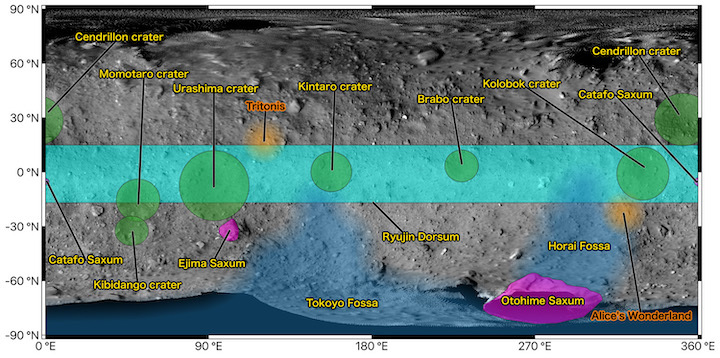
Figure 1: Map of Ryugu showing the place names.
Trinitas and Alice’s Wonderland are nicknames of the MINERVA-II1 and MASCOT landing sites, respectively, and not place names recognized by the IAU. (Image credit:JAXA ※2)
(2019.02.04, Correction: In the original article, the MINERVA-II1 site name was given as “Trinitas” but has been corrected to “Tritonis”.)
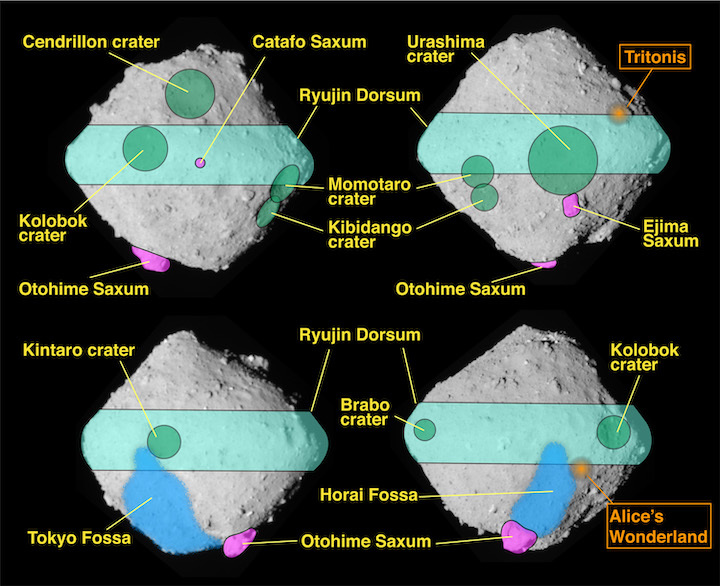
Figure 2: The location of place names on Ryugu.
Tritonis and Alice’s Wonderland are nicknames of the MINERVA-II1 and MASCOT landing sites, respectively, and not place names recognized by the IAU. (Image credit:JAXA ※2)
(2019.02.04, Correction: In the original article, the MINERVA-II1 site name was given as “Trinitas” but has been corrected to “Tritonis”.)
As it is difficult to get a feel for how the place names were chosen from just a list, we will introduce the story behind the main choices below.
The asteroid name “Ryugu” comes from the Japanese fairy tale of Taro Urashima. In the story, Urashima is a fisherman who rescues a sea turtle from the cruelty of a group of children. The turtle takes Urashima to the underwater palace of Ryugo-jo (Dragon Palace), where he meets the princess, Otohime. After 3 years, Urashima wishes to return home and is given a treasure box (tamatebako) by Otohime with instructions never to open it. But when Urashima returns to the surface, he discovers everything he knew has changed as 300 years has actually past. In confusion, Urashima opens the treasure box and is engulfed in white fog. When it clears, he has become an old man, as the box contained his age.
With the name of the asteroid being Ryugu, there was a strong desire from the Project to use other names that appear in Urashima’s story for major asteroid topography. However, place names cannot be common nouns so words such as “sea bream”, “flounder” and “turtle” do not work and we were limited to names such as Taro Urashima, Otohime etc.
Therefore, “Urashima” was chosen for the biggest crater on Ryugu and “Otohime” for the largest boulder near the south pole. Both of these are very important features for deciphering the formation history of Ryugu. However, Otohime had already been used! Venus (whose place theme uses the names of goddesses) had already a location named Otohime Tholus. Otohime was therefore initially refused by the IAU when it was proposed. But Otohime is an extremely important person in the story of Taro Urashima and how can we collect the tamatebako if Otohime is not on Ryugu?! (That was a joke, but we did want to use such a relevant name.) Since the name was important to the Project, the place name core members refined the proposal to the IAU, explaining why Otohime should be one of the main topological features on Ryugu and this was accepted.
A defining feature of Ryugu is that the shape is similar to a spinning top or abacus bead. This shape is the combination of two cones which appear almost circular when seen from the north pole. The ridge where they join was named “Ryujin”, after the ruler of the Dragon Palace who is the father of princess Otohime. This name came from the Place Name Core Members who felt the ridge resembled a dragon coiling around the asteroid or an ouroboros (the image of the serpent or dragon that swallows its own tail). (There was actually a similar illustration in the “Imagining Ryugu” art contest!)
On either side of Otohime saxum there are large grooves extending in the equatorial direction. In the story of Taro Urashima, Otohime lives in this mysterious place at the bottom of the ocean which is sometimes depicted as a different world in the various retellings of the tale. This world is often called “Horai”, “Tokoyo” or “Niraikanai”. The grooves adjacent to Otohime saxum were therefore named Horai fossa and Tokoyo fossa.
There is a reasonably big boulder to the southeast of the Urashima crater. According to one version of the tale, the place where Taro Urashima helped the turtle and left to travel to Ryugu-jo is the place “Ejima”, which gave the boulder its name Ejima saxum.
There are also large craters on both sides of Urashima crater. In particular, there are two craters stuck together along the north-south direction to the west. This state reminded us of the kibidango (Japanese dumplings) in another Japanese fairy tale called Momotaro. The northern crater of the pair was therefore named “Momotaro crater” and the southern crater became “Kibidango crater”. To the east of the Urashima crater, there is a crater with big black boulder inside. This reminded us of the Japanese tale of Kintaro, a boy with super strength who carried a broad-axe, and so was named “Kintaro crater”.
Ryugu also has topological names derived from children’s stories from outside Japan. For example, while you might not immediately recognize the name of the Cendrillion crater, the name is from the original French name for the familiar fairy tale, “Cinderella”. The name of the Brabo crater is derived from the name of the hero of a Netherlands tale, which was proposed by the overseas project members. The Kolobok crater and Catafo saxum were both names proposed by the IAU WG. They are taken from Russian and Cajun (famous for Cajun cuisine in the USA) folktales.
These are the place names formally recognized by the IAU WG. In addition, there are two nicknames shown in Figures 1 and 2; Trinitas (the MINERVA-II1 landing site and named for the goddess Minerva’s birth place) and Alice’s Wonderland (the MASCOT landing site). These were places named by the project to identify the points where MINERVA-II1 and MASCOT landed, but are not official names recognized by the IAU.
We are planning to review and propose place names from time to time as we continue to observe and research asteroid Ryugu. What kind of story should appear on Ryugu next?
Quelle: JAXA
----
Update: 21.02.2019
.
Japanese spacecraft to attempt landing on distant asteroid
Japanese spacecraft approaching asteroid about 280 million kilometers (170 million miles) from Earth
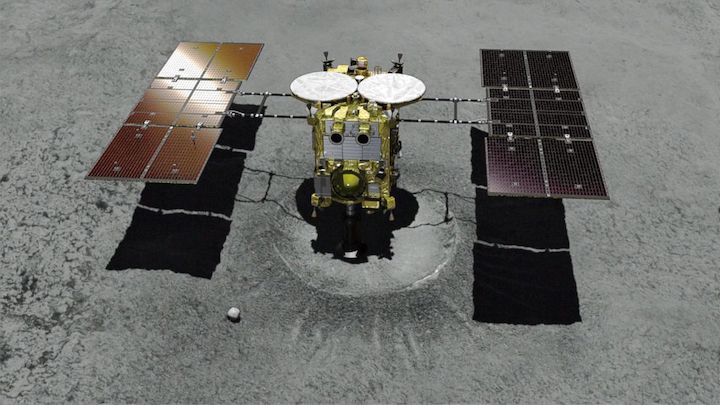
A Japanese spacecraft began its approach Thursday toward a distant asteroid on a mission to collect material that could provide clues to the origin of the solar system and life on Earth.
Hayabusa2's descent was delayed for about five hours for a safety check, but the unmanned craft is still due to touch down as scheduled on Friday morning, the Japan Aerospace Exploration Agency said.
During the touchdown, which will last just seconds, Hayabusa2 will extend a pipe and shoot a pinball-like bullet into the asteroid to blow up material from beneath the surface. If all goes successfully, the craft will then collect samples that would eventually be sent back to Earth. Friday's attempt is the first of three such touchdowns planned.
The brief landing will be challenging, because of the uneven and boulder-covered surface. Hayabusa2 is aiming for a 6-meter- (20-foot-) diameter circle to avoid obstacles. Space agency controllers will direct its approach until it is 500 meters (1,600 feet) above the asteroid's surface, after which it will be on its own because it takes 20 minutes for commands from Earth to reach the craft.
JAXA, as the Japanese space agency is known, has compared landing in the circle to landing on a baseball mound from its height of 20 kilometers (6 miles) above the asteroid.
The asteroid, named Ryugu after an undersea palace in a Japanese folktale, is about 900 meters (3,000 feet) in diameter and 280 million kilometers (170 million miles) from Earth.
Quelle: abcNews
+++
Hayabusa-2: Japan mission set to 'bite an asteroid'

A Japanese spacecraft is set to "bite an asteroid" as it descends to collect a sample of rock from the surface.
The Hayabusa-2 probe will try to grab the sample from a pre-chosen site on the asteroid Ryugu at 23:00 GMT on 21 February.
The spacecraft reached asteroid Ryugu in June 2018 after a three-and-a-half-year journey from Earth.
It is is expected to return to Earth with the rocky material it has cached in 2020.
During sample collection, the spacecraft will approach the 1km-wide asteroid with an instrument called the sampler horn. On touchdown, a 5g projectile made of the metal tantalum will be fired into the rocky surface at 300m/s.
The particles kicked up by the impact should be caught by the sampler horn.
The spacecraft began descending from its "home position" of 20km above the asteroid's surface in the early hours of 21 February (GMT) - several hours later than planned. However, controllers said they would slightly increase the speed of descent down to 5km, so that the original touchdown time was not affected.
Ryugu belongs to a particularly primitive type of space rock known as a C-type. The near-Earth asteroid (NEA) is a relic left over from the early days of our Solar System.
Prof Alan Fitzsimmons, from Queen's University Belfast, told BBC News: "We think we understand how carbon-rich asteroids migrate from the asteroid belt to become near-Earth asteroids, but the samples from Ryugu will allow its history to be explored.
"After the Rosetta mission, it's now clear that most of Earth's water did not come from comets in the early days of the Solar System. We believe carbon-rich (C-type) asteroids may have significant amounts of water locked up in their rocks. It's possible such asteroids may have brought to Earth both the water and the organic material necessary for life to start.
"These samples will be crucial in investigating this possibility."
Hayabusa-2 has already dropped a small, reflective, beanbag-like "target marker" on to Ryugu. This will be used as a guide as the spacecraft descends to the rough surface of the asteroid.
Controllers will aim for the centre of a circle, some 6m in diameter, located about 4-5m away from the target marker.
The Japanese space agency (Jaxa) had originally planned to carry out the touchdown operation in October last year. But the asteroid's surface was found to be much more rugged than expected, with numerous, hefty boulders making it hard to find a location that was large and flat enough to sample.
Controllers had hoped they would have an area of about 100m in diameter to target. But because of the surface properties, this had to be reduced to a 6m circle for what team members are calling a "pinpoint touchdown".
The sampler horn that extends out from the bottom of the spacecraft has a length of 1m. It's therefore vital that there are no boulders more than 50cm in height at the landing site, to reduce the chances that the body of the spacecraft could hit a rock.
Unexpected surface properties also have the potential to affect the amount of material collected. Before arriving at Ryugu, researchers had expected the surface to be covered in a powdery layer of fine-grained material - the regolith.
In fact, the upper layer turned out to be akin to gravel, consisting of rocky chunks that are centimetre-sized or larger.
Prof Fitzsimmons told BBC News: "This was a surprise, as other near-Earth asteroids we have visited previously have shown areas dominated by small particles.
"It might be due to the carbon-rich composition, as the previous NEAs are composed of silicate rock, which are more Earth-like. But the shape of Ryugu also implies it was spinning much faster in the past, so it's possible this could have affected the particles' sizes in some fashion."
Scientists carried out additional tests in Japan to determine whether the sample material could still be gathered by the spacecraft.
They used a container of artificial gravel with a similar size distribution to that on Ryugu. In a vacuum chamber, they fired a tantalum bullet identical to that used by Hayabusa-2 into the gravel.
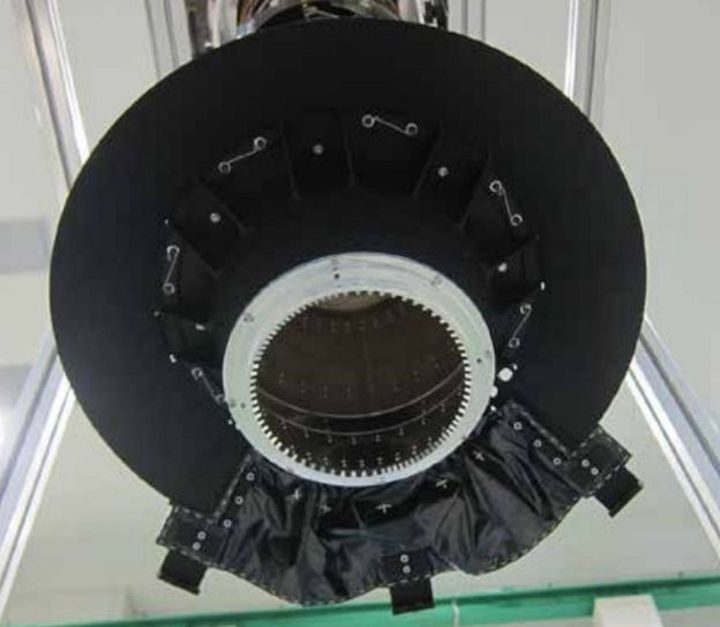
The sampler horn will be used to collect material for delivery to Earth in 2020
According to Jaxa, the results of the test exceeded expectations, with the tantalum projectile yielding fragments of rock in size ranges that should easily pass through the sampler horn.
This suggests that Hayabusa-2 should still be able to collect a sample.
In September, Hayabusa-2 deployed two robotic "hoppers" that propelled themselves across the surface of Ryugu, sending back images and other data.
Then, in October, the "mothership" despatched a French-German instrument package called Mascot to the surface.
Later this year, perhaps in March or April, Jaxa plans to detonate an explosive charge that will punch a crater into the surface of Ryugu.
Hayabusa-2 would then descend into the crater to collect fresh samples of material that have not been altered by aeons of exposure to space.
"We know that the surfaces of asteroids are changed over time by bombardment with energetic particles from the Sun and interstellar space," said Alan Fitzsimmons.
"Yet studies with telescopes show that this 'space weathering' affects the surfaces of carbon-rich asteroids differently to those mostly made from more rock-like silicate minerals. We don't know why this is, and the fresh sub-surface samples from Ruygu will play a very important role in understanding how this happens."
Quelle: BBC
----
Update: 22.02.2019
.
Images from the BOX-B operation
in January 2019
We are now finally approaching the time for touchdown, but just before this, we would like to show everyone the images from the BOX-B operation that was conducted in January.
The BOX-B operation is where the altitude (distance from the surface) is kept at about 20 km while the spacecraft moves in the north-south and east-west direction to observe Ryugu from different angles (for more details.).
Previous BOX-B operations were carried out from August to September last year (see http://www.hayabusa2.jaxa.jp/en/topics/20180927e_BoxB). At that time, we observed the south pole side of Ryugu (first BOX-B observation) and the evening side of Ryugu (second BOX-B observation). This time, we performed two further BOX-B observations to view the asteroid when the Sun is in opposition (third BOX-B observation) and the north pole side of Ryugu (fourth in total BOX-B observation).
Images from opposition
The third in total BOX-B operation was conducted from January 5 ~ 12. Here, we performed something known as an opposition observation. In this observation, Hayabusa2 is in the same direction as the Sun when seen from the asteroid. In other words, if you were standing on the asteroid, you would see Hayabusa2 overlapping with the Sun. If you replace Ryugu with the Earth and Hayabusa2 with the Moon, this would be a total solar eclipse. However, at the distance of the BOX-B observations, Hayabusa2 cannot hide the Sun and would be seen as a small point projected on the Sun from Ryugu. More exactly, opposition is when the angleθ(the phase angle) between the spacecraft and Sun in Figure 1 becomes zero.
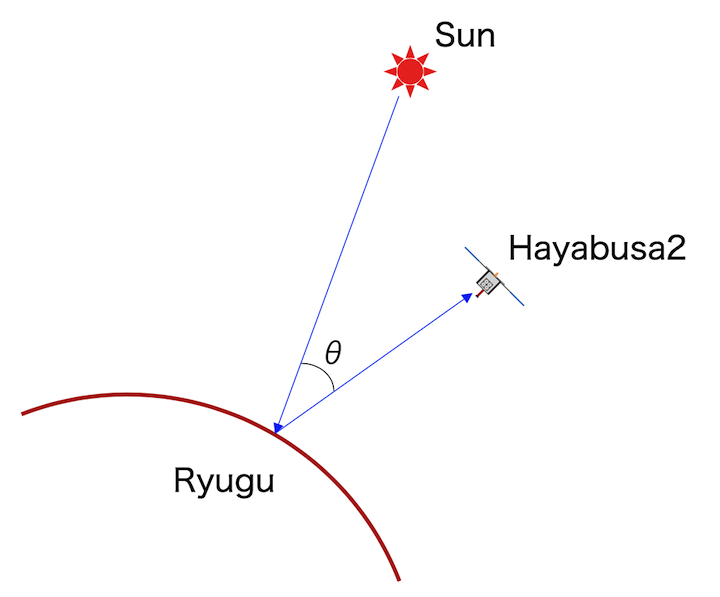
- Figure 1: Positional relationship between the Sun, Ryugu and Hayabusa2.
The angle θ is called the phase angle. (Image credit: JAXA).
Figure 2 shows the image captured during these observations. The photograph was taken at about 19:12 JST on January 8, 2019, using the Optical Navigation Camera – Telescopic (ONC-T). The atmosphere in this shot is quite different from the photos we have published so far. Overall, the contrast is low and the image appears flat and featureless, making it difficult to see the surface conditions. This is known as the “opposition effect”; a phenomenon in which a celestial body with an uneven surface or one covered with regolith (gravel) appears brighter when the phase angle is close to zero. This occurs because as the phase angle shrinks, the many fine shadows caused by the rough surface disappear.
As you can see in Figure 2, the brightness in the vicinity of the center of Ryugu is the same as that in the peripheral regions. It is difficult to gain any kind of stereoscopic feeling of Ryugu’s surface from this image. In Japanese, we have the expression “bon no yoo na tsuki” or “the moon is like a round tray”. This is because when the Moon is full, the brightness is also equal at the edges and the center which gives it the appearance of a flat disc rather than a sphere. More professionally, this means that “there is no peripheral dimming” which is due to the opposition effect.
There is one point that shines white in this image. This is the target marker (TM-B) that was dropped to the surface of Ryugu in October last year, shining as it reflects the Sun’s light. We were able to confirm the target marker reflects the Sun’s light from a distance of 20 km away. That is exactly the site where Hayabusa2 will try to touchdown. For comparison, Figure 3 shows an image not in the direction of opposition.

Figure 2: Ryugu images from the direction of opposition.
The photograph was captured at around 19:12 JST on January 8, 2019, using the Optical Navigation Camera – Telescopic (ONC-T). The white dot at the arrow tip is the target marker. The distance to Ryugu is about 20 km.
(Image credit *: JAXA, University of Tokyo, Kochi University, Rikkyo University, Nagoya University, Chiba Institute of Technology, Meiji University, University of Aizu, AIST.)
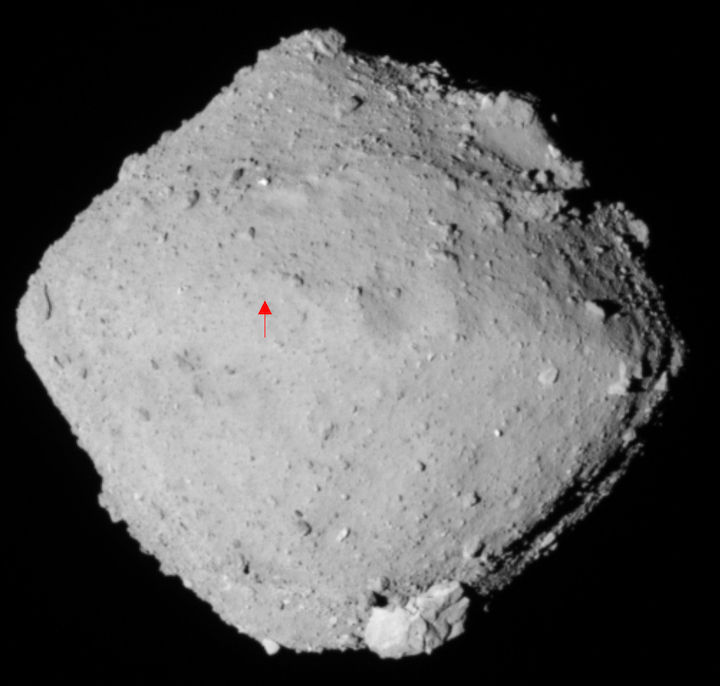
- Figure 3: Image captured when not in opposition (captured from approximately the same direction as in Figure 2).
The photograph was taken with the Optical Navigation Camera – Telescopic (ONC-T) on July 12, 2018. The phase angle when this image was taken was about 19 degrees. Since this was taken before the target marker was dropped, it cannot be seen on the surface of Ryugu. The arrow tip marks the planned touchdown point.
(Image credit *: JAXA, University of Tokyo, Kochi University, Rikkyo University, Nagoya University, Chiba Institute of Technology, Meiji University, University of Aizu, AIST.)
As we have taken many pictures from the direction of the Sun previously, you may wonder why it is only this time that the photographs are like that shown in Figure 2. For example, Figure 4 shows an image taken with the Optical Navigation Camera – Wide angle (ONC-W1) during our touchdown rehearsal, TD1-R3, when the target marker was dropped.
You can see a black dot near the center of Figure 4, which is the shadow of the spacecraft. Where this shadow is present, the phase angle (θ in Figure 1) is zero. The region around the shadow has brightened as a result of the opposition effect. However, as you move outwards from the shadow position, you can see surface features on the asteroid as normal. This is because the phase angle has become larger further from the shadow position, so no opposition effect appears.
The photograph in Figure 4 was taken when Hayabusa2 was close to the asteroid. But during this BOX-B observation, the phase angle is close to zero over the entire asteroid as we are imaging from a distance of about 20 km (the maximum phase angle reaches about 1.5 degrees). This is the reason why the entire asteroid appears featureless in this image due to the opposition effect.
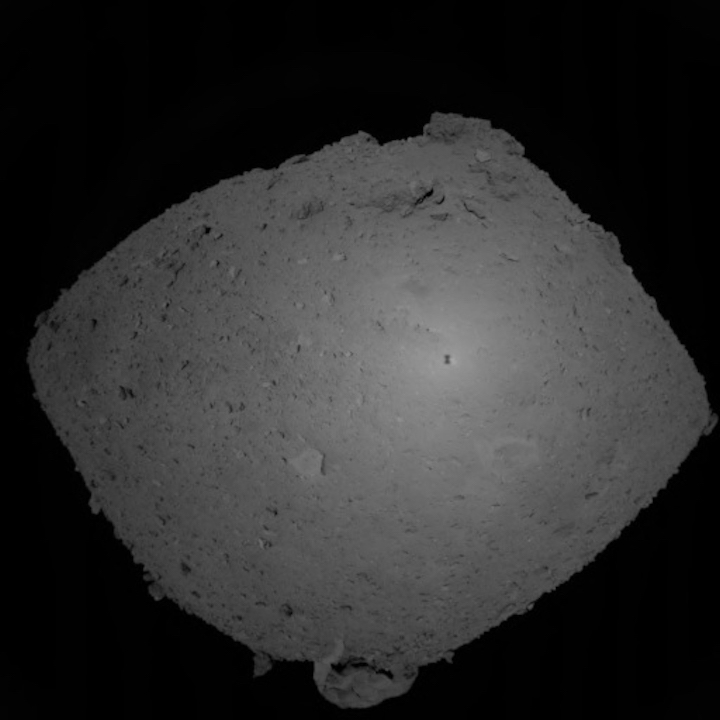
- Figure 4: Image taken with the Optical Navigation Camera – Wide angle (ONC-W1) on October 25, 2018.
The small black dot near the center of the image is the shadow of the spacecraft. This shadow occurs where the phase angle becomes zero and the opposition effect brightens the surrounding area. The shape of Ryugu is distorted in this image due to being photographed by with the wide-angle camera quite close to Ryugu (altitude about 450 m).
(Image credit: JAXA)
Images near the north pole
The fourth BOX-B operation took place between January 18 ~ 31 where we observed the north pole of Ryugu. In the BOX-B operation performed last year from August to September, we observed Ryugu’s south pole region, so this time we moved to observe around the north pole. The captured image is shown in Figure 5.
Figure 5 shows a diagonally imaged photograph of Ryugu, captured by moving the spacecraft towards the direction of the north pole. The upper side of the image shows the north pole and reveals a landscape dominated with many large boulders. The white band extending to the left and right slightly below the center of the image is the equatorial ridge (Ryujin Ridge). The arrow tip marks the planned touchdown site and you can see this site is on the main ridge.
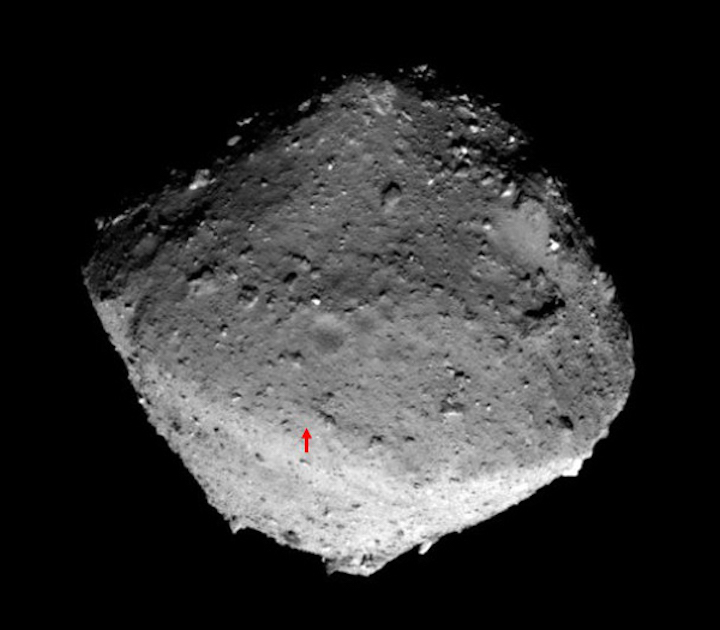
- Figure 5: Ryugu photographed with the Optical Navigation Camera – Telescopic (ONC-T) at around 16:33 JST on January 24, 2019.
The northern hemisphere of Ryugu fills most of the image. The tip of the arrow indicates the intended touchdown point.
(Image credit *: JAXA, University of Tokyo, Kochi University, Rikkyo University, Nagoya University, Chiba Institute of Technology, Meiji University, University of Aizu, AIST.)
This is the first time we have images the northern hemisphere of Ryugu. In this observation, we acquired data on the equatorial region of Ryugu, the southern and northern hemisphere. Imaging the entire area is very important for creating accurate global shape models for Ryugu.
*:Please use the displayed credit when reproducing these images. In the case where an abbreviated form is necessary, please write "JAXA, University of Tokyo & collaborators".
Hayabusa2 project
2019.02.20
Quelle: JAXA
+++
Navigation Images from the TD1-L08E1
operation (Real time delivery)
We are currently delivering navigation images with the Optical Navigation Camera Wide angle (ONC-W1) in real time.
Please understand that the image may be distorted due to the network status or data processing.
- The page displays the latest list of images at the time of loading. Please reload the browser window to update to the latest image.
- Time is given in UTC (Universal Time). For Japan time (JST), please add 9 hours. For Eastern Time (ET), please subtract four hours.
- We cannot obtain real time images during the touchdown-phase. To know the operation information of that period, please see Twitter and/or live web stream (6:45 - 9:15 JST on Feb. 22)
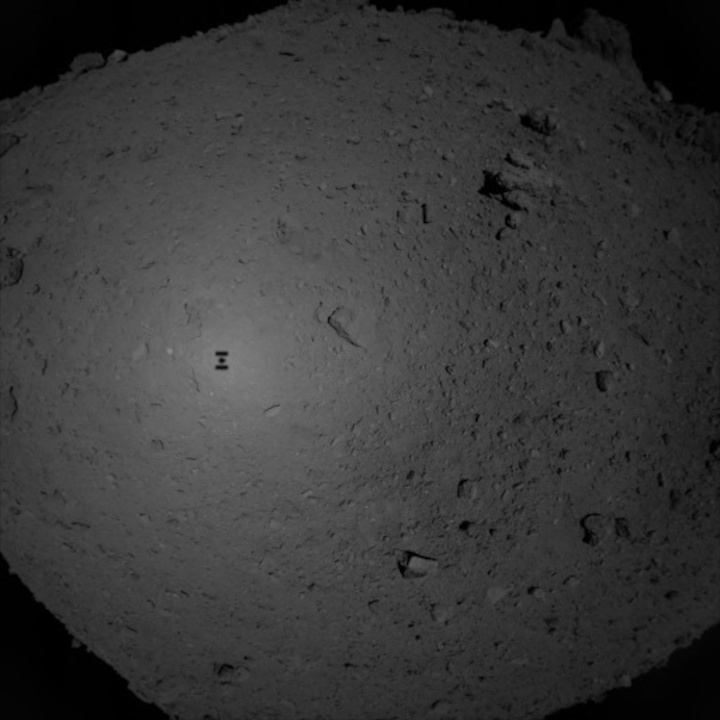
Received time: UTC 2019-02-21 22:02
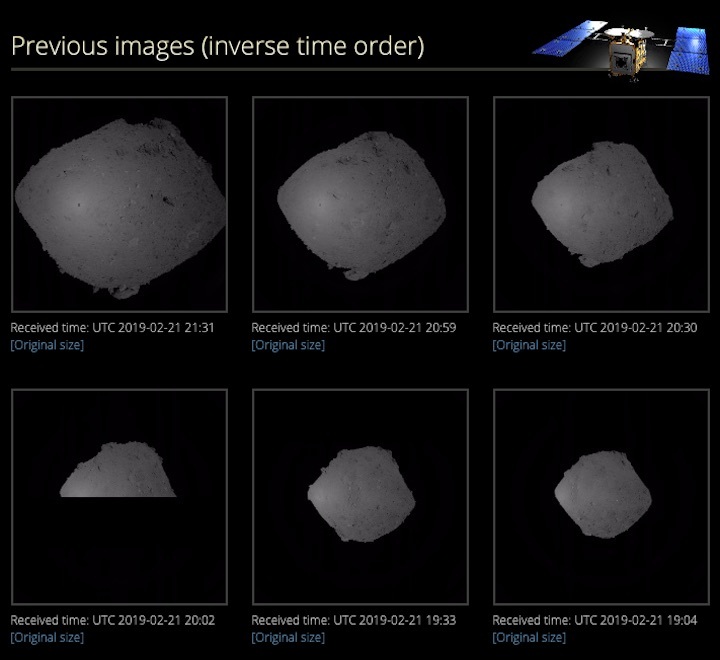
Quelle: JAXA
